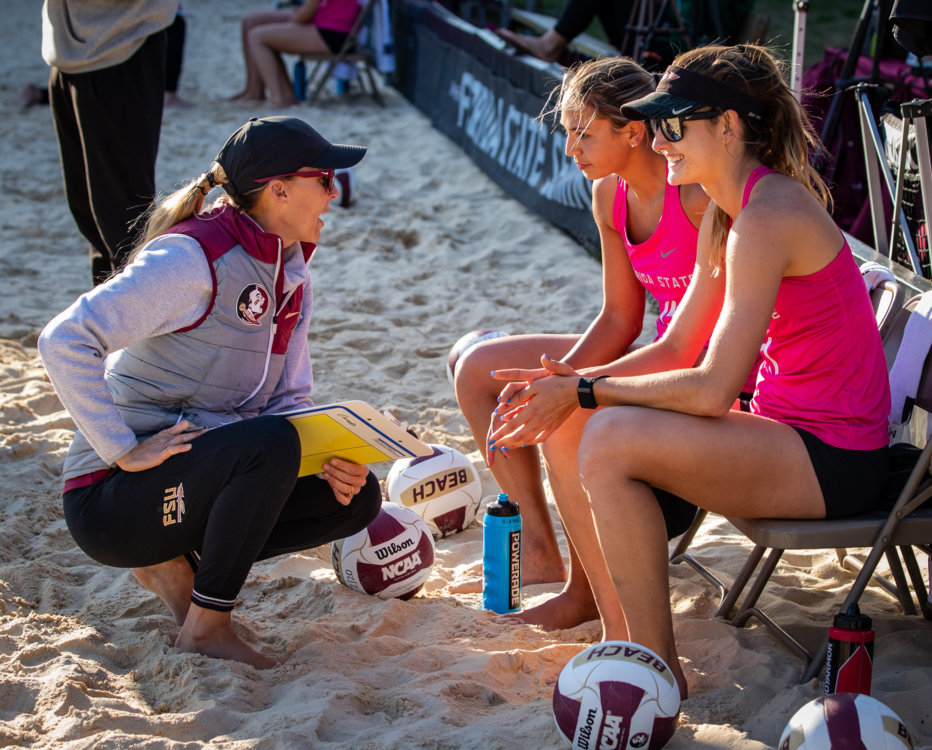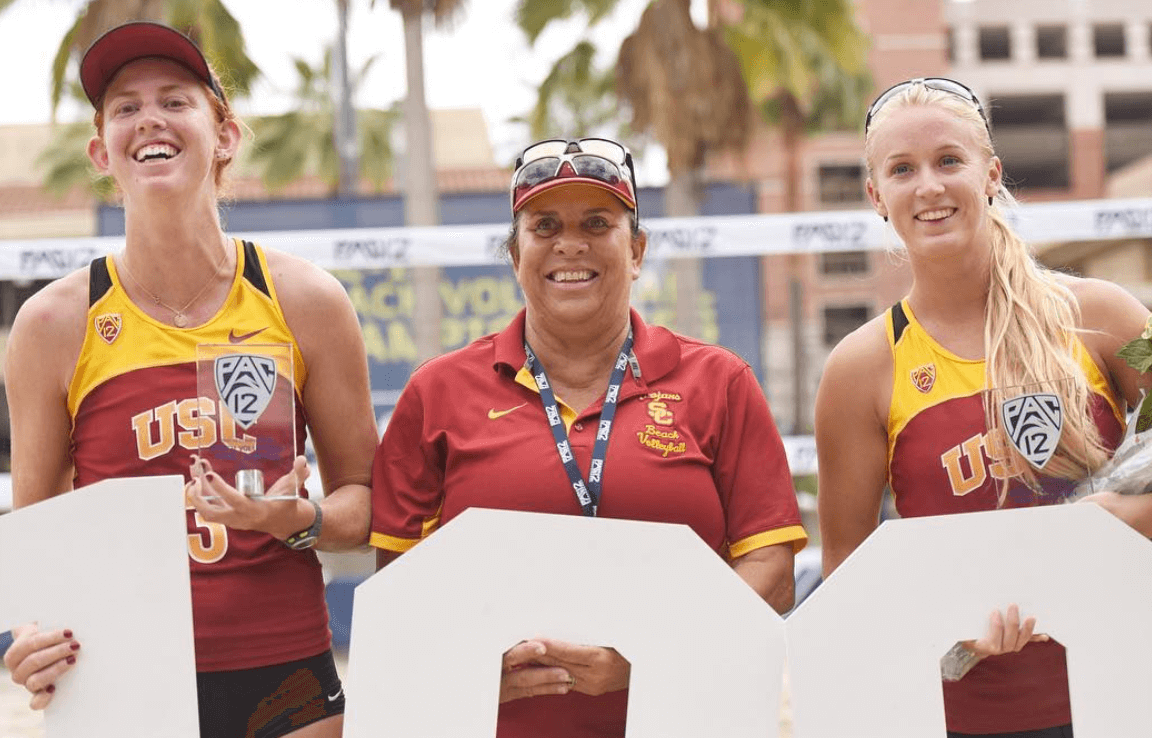NCAA Beach Volleyball is one of the fastest-growing college sports ever.
When beach volleyball (then known as sand volleyball, which… glad they changed it) debuted in 2011 as a club sport, there were 15 NCAA-affiliated teams. Once it became an NCAA-sanctioned sport in 2016, there were 56 beach volleyball teams. As of July 2019, there were 75 Division I, II, and III programs across the nation. That’s a 400% increase since 2011.
So how is this wildfire of growth changing the game?
Most obviously, it’s spawning new players. Not only does NCAA’s existence offer more scholarship opportunities (185.5, to be exact), but it also exposes kids to the game at a younger age. AVP First and AVP America are doing their part to get these youngins ready for college and beyond; they have 170 affiliated clubs nationwide. With the chance to compete on a beach volleyball team in college, more 12 to 18-year-olds are playing than ever before. Just come to Hermosa in July; there’s a Juniors tournament every weekend that packs our beaches with young talent, culminating in the AVP First National Championship (played alongside the pros at the AVP Hermosa Beach Open). It’s so fun to watch those studs play their hearts out for the love of the game.
Beach is notorious for making a more well-rounded volleyball player, as well. Take it from me, a former middle who specialized at three skills – blocking, hitting, and being tall. Beach has enhanced my overall skill-level and volleyball IQ tenfold. Many indoor players are doubling up and competing for both. In the 2018-2019 season, there were 407 crossover players in the NCAA. Most of these players return to the gym and realize the sand has improved their game. Whether those girls stick with beach or continue on in indoor, NCAA’s beach presence is making them better volleyball players.
So now that AVP First and AVP America, among other organizations and clubs, are training our youth up in the game, stellar young talent is entering college with a few years of beach under their belt. Then they get four more years of instruction from some of the best coaches in the game. AVP’s own Amazon Prime commentator (and Gold Medalist, no big deal) Dain Blanton took over USC’s beach program and is beginning his first season with the Trojans. Former AVP stars coach DI teams all over the country – Todd Rogers at Cal Poly, Stein Metzger at UCLA, John Mayer at LMU, and Brooke Niles at FSU, among others. I talked with John and Brooke last week about the NCAA’s influence on the game.
Something they both highlighted that intrigued me was the team aspect. In NCAA competition, universities match up their five best teams and call it a duel. A duel is best three out of five matches, which means you could lose your individual match and still win the day. It also means the adverse. So a sport that is highly individual on the pro tour is profoundly team-oriented at the college level.

Photo via Florida State University Athletics
Brooke loves that the NCAA has created this team environment. John agrees and reminds his players of this often: “You’re in the boat. You can either put your head down and row as fast as possible or you can row against us. Or you can be dead weight. We can be our best and go the direction we want to if everyone is rowing as fast as they can.” In college beach volleyball, you’re not just playing for a win for you and your partner. If you’re on the 1s team, you play the best team of the opposing school, and on down the line. Each of the five matches count for one point towards the duel, and the first school to three points wins. So the 5s match is just as important as the 1s. This structure offers a different look at the sport, a different feel for the spectator, and provides all the benefits of teamwork that indoor specializes in. The team environment hones communication skills, motivates players outside of the top five teams to improve, and promotes the kind of lifelong friendships that you get from playing collegiate sports (as long as you have a cool team).
John and Brooke also confirmed something I suspected – it’s not just the extra reps and training that benefit collegiate players. It’s the confidence they gain, specifically from playing tight matches that come down to the wire. A graduating college senior has played thousands of hours of volleyball and competed in hundreds of matches. Five years ago, we didn’t have that. It took (some of us) years to learn the game, and even more to consider ourselves professionals. College gives you the chance to play and win important matches earlier. That’s crucial to confidence on the AVP and FIVB.
You can see this in action today. AVP stars Sarah Sponcil and Kelly Claes are freshly minted NCAA Champions and already among the top 10 teams in the world. “The biggest difference [after beach became an NCAA sport] is,” John says, “well you can see it on the men’s side — players don’t really make an impact until maybe they’re thirty. Now, the women get so much experience in college and high school. They get battle-tested. They get served a bunch of balls, have to figure out the game. And they’re able to, the next year, come out into the AVP and the FIVB and be successful. It’s huge — I wish the men had it.”

Photo via @smsponcil on Instagram
Brooke also emphasized the edge NCAA beach athletes are getting. “The kids in college now are so used to the high-level competition, and sometimes they’re getting better training than those playing at the pro level.” Brooke also notes the way college beach is bringing new fans to the game. “ESPN has done an amazing job with [the National Championships in] Gulf Shores. The viewership just keeps increasing and people are really excited to watch it.”
NCAA athletes are coming out of college ready for the AVP. Even before they leave, some are making the Main Draw and going deep in tournaments. And not just the big names. Pepperdine’s Skylar Caputo got third place in Seattle 2017 when she was a sophomore. When Allie Wheeler and Nicolette Martin were still at USC, they got a 9th at the 2016 MBO (I know this because they beat me… ugh). Brooke says every single one of her athletes has played in an AVP Qualifier. So these players aren’t waiting till they graduate to make waves; they’re a part of the pro circuit playing as amateurs before they get their degrees.
That makes for a gnarly Qualifier… Every. Single. Tournament. “It affects the depth of the tour,” John says. “Before, maybe it felt like you had more security as a Main Draw player. Now you know there’s a new crop of players coming in, and those players are elevating your game. The women’s tour is the deepest I’ve ever remembered it.”
If all of this has occurred in just the first five years of NCAA Beach Volleyball, I can’t imagine what’s in store for our sport. All I know is I better turn this article in and get practicing; I have 1,165 NCAA athletes gunning for my spot in the AVP.
**Thank you to Brooke Niles and John Mayer for their time and insight. And thank you to AVCA for their up-to-date stats.
—–
Follow Kim Smith on Instagram @kimesmith21
Read more from Kim:
Strategy Chat with Reid Priddy
